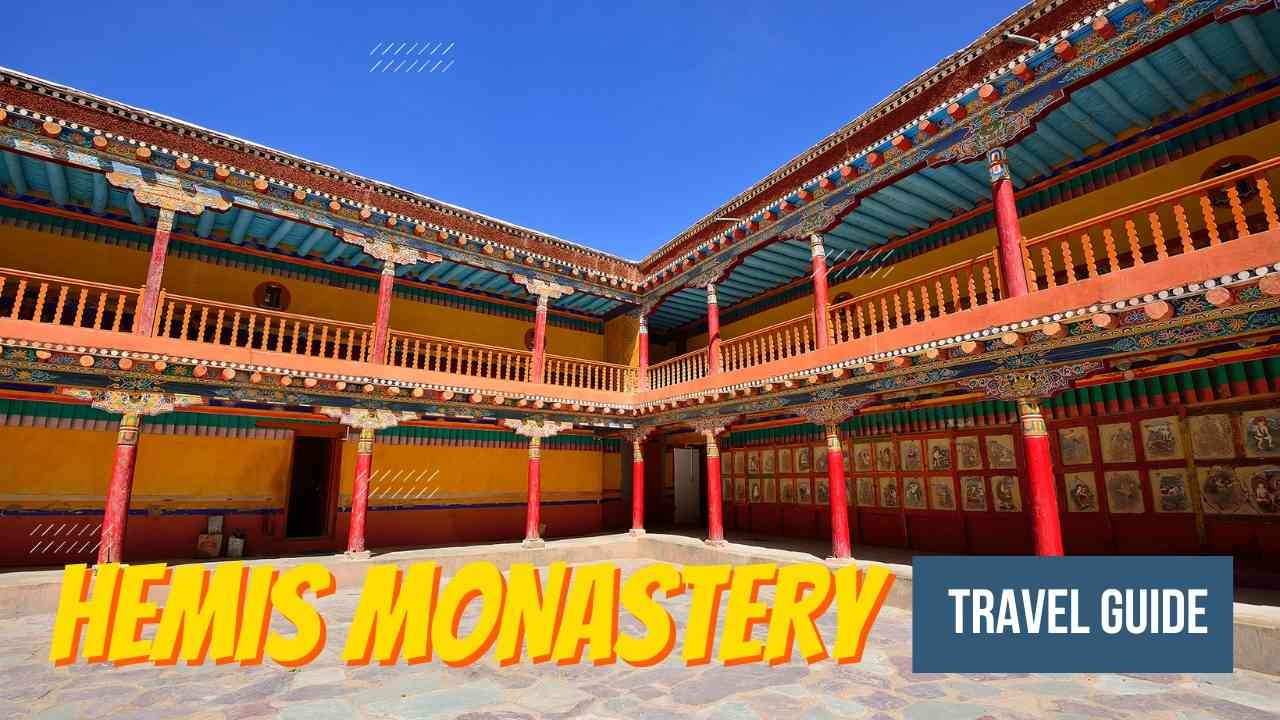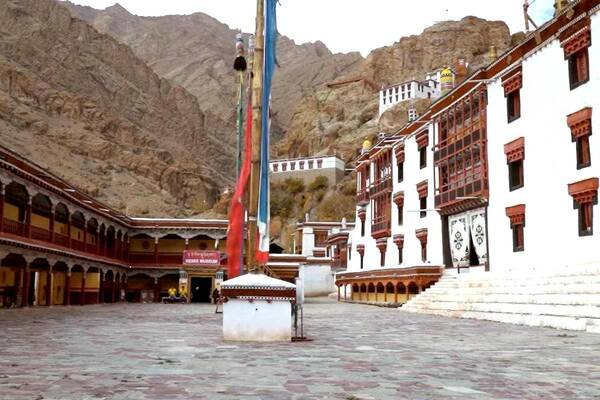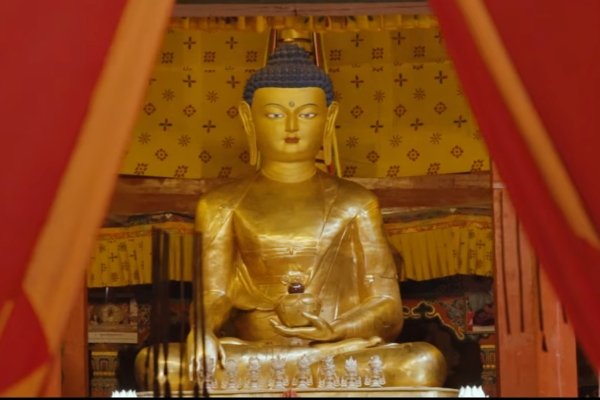
Hemis Monastery is a location that seems to be a portal to another universe hidden amid the untamed beauty of the Himalayan highlands. This ancient Buddhist monastery is more than a place of spiritual solace; it’s a trip through time and culture. It’s hidden away in the tranquil surroundings of Ladakh, India. Join us on an expedition as we discover the enigma and appeal of the Monastery, a location where spirituality and spectacular natural beauty meet.
Hemis Gompa is about 45km from mainland Leh and is perched at more than 12,000 feet above sea level; it is a jewel in Ladakh’s crown and is renowned for its spiritual significance and mysterious past. Hemis Monastery is home to many fascinating and inspiring secrets, from the yearly Hemis Festival, which dazzles with vibrant masks and centuries-old traditions, to the dispute surrounding claims of ancient manuscripts. This monastery has everything you could possibly want, whether you’re looking for spiritual awakening, a close relationship with nature, or a window into the diverse culture of Ladakh.
Join us on this virtual journey as we explore Hemis Monastery’s many facets and give you a complete travel manual to ensure your unforgettable trip. Prepare to embark on a journey of discovery and introspection as we explore the spiritual treasure of Ladakh.
Nestled in the heart of the Himalayan mountains, Hemis Monastery is a testament to Ladakh, India’s rich cultural and spiritual heritage. This ancient Buddhist monastery, believed to have been founded in the 11th century by the renowned yogi Naropa, has a history of mysticism and devotion.
Hemis Monastery is closely associated with the Drukpa lineage of Tibetan Buddhism, and it played a pivotal role in spreading the teachings of the Drukpa masters across the Himalayan region. Over the centuries, the monastery has been a center for meditation, learning, and spiritual practice, attracting scholars and monks from far and wide.
One of the monastery’s most significant historical events was the visit of Guru Padmasambhava, also known as Guru Rinpoche, who is credited with introducing Buddhism to the region. The monastery’s annual Hemis Festival, celebrated with vibrant masked dances and rituals, commemorates his birth and attracts pilgrims and tourists alike.
Hemis Monastery’s history is steeped in spirituality and shrouded in a fascinating tale of controversy and intrigue. In 1894, Russian journalist Nicolas Notovitch boldly claimed that the Monastery held the origins of a mysterious gospel known as the “Life of Saint Issa, Best of the Sons of Men.” According to Notovitch, this gospel suggested that Jesus had ventured to India during his ‘lost years.’ His account stated that the manuscript had been carefully preserved within the Hemis library and that the monks had shared it with him during his stay at the monastery, where he was recovering from a broken leg.
However, doubts emerged as time passed and historians scrutinized Notovitch’s story. It is widely alleged that Notovitch later confessed to having fabricated the evidence, casting a shadow of doubt over his claims. Bible scholar Bart D. Ehrman unequivocally stated, “Today there is not a single recognized scholar on the planet who has any doubts about the matter. The entire story was invented by Notovitch, who earned a good deal of money and a substantial amount of notoriety for his hoax.”
Yet, intrigue remains. Indian Pandit Swami Abhedananda also asserted that he had encountered the same manuscript during his visit to Hemis in 1921. He claimed to have read it with the assistance of a “local Lama interpreter.” However, after Abhedananda’s passing, it was revealed that the documents had mysteriously disappeared from the monastery, echoing the enigmatic nature of Hemis Monastery’s history. The story of the disputed manuscript continues to captivate scholars and enthusiasts alike, adding a layer of mystique to the monastery’s already complex narrative.
As you step into the sacred precincts of Hemis Monastery Ladakh, one of the first things that captivate your senses is its remarkable architecture. This ancient Buddhist haven, nestled within the rugged Himalayan terrain, boasts a design reflecting spiritual reverence and historical significance.
Traditional Tibetan Influence
The Monastery’s architectural style is deeply rooted in Tibetan traditions. Its whitewashed walls intricately carved wooden windows, and colorful prayer flags fluttering in the mountain breeze create an enchanting visual harmony. The monastery’s structure seems almost like a natural landscape extension, blending seamlessly with the majestic mountains surrounding it.
The Courtyard and Assembly Hall
At the heart of the monastery lies a spacious courtyard, a serene oasis where monks engage in meditation and rituals. The monastery’s key buildings encircle the courtyard, including the grand assembly hall known as the Dukhang. The Dukhang is a magnificent structure adorned with traditional Tibetan motifs, elaborate frescoes, and a vibrant array of Buddhist thangkas (scroll paintings).

Intricate Details
Take a closer look at the architecture, and you’ll be amazed by the level of detail. The wooden beams and columns are often adorned with intricate carvings, each telling its own story from Buddhist scriptures. The windows, too, are not mere openings to let in light but are elaborately designed with geometric patterns and mythical symbols.
The Golden Stupa
One of the most striking features of Hemis Gompais is its golden stupa, or chorten, which stands tall and gleaming in the courtyard. This iconic structure symbolizes the monastery’s spiritual significance and devotion to the Buddha’s teachings.

Monastic Cells
As you explore further, you’ll encounter the monks’ living quarters, known as monastic cells. These simple yet functional rooms provide a glimpse into the daily life of the resident monks and their commitment to a life of spiritual practice.
Hemis Monastery’s architecture isn’t just about aesthetics; it’s a testament to the enduring spirit of Tibetan Buddhism and the cultural heritage of Ladakh. The intricate craftsmanship, serene ambiance, and natural beauty make this monastery a true architectural marvel, inviting travelers to immerse themselves in its visual and spiritual splendor.
So, as you walk through the labyrinthine corridors and courtyards of Hemis Gompa, don’t forget to pause and admire the architectural wonders that have stood the test of time, serving as a bridge between the earthly and the divine.
Ladakh’s closest airport to Hemis Monastery is Leh’s Kushok Bakula Rimpochee Airport, around 60 kilometers away. Frequent flights connect Leh from key Indian cities such as Delhi, Mumbai, and Srinagar.
Upon your arrival in Leh via air, it’s advisable to take a day for acclimatization before embarking on your journey to the Monastery.
You may click here to learn more about how to get acclimatized in Leh.
The Monastery can be visited by hiring a car from the Local Taxi Union or via Road Expeditions. We will guide you for the complete tour along with other nearby places to visit.
You can hire a local bike from Leh or we can deliver the bike to your hotel. You may then Manali Leh Highway to reach the Monastery.
The ideal time to explore Hemis Monastery is from May to October, spanning the warmer months when Ladakh enjoys its most favorable weather conditions. The roads leading to Ladakh are open during this time, making it the perfect window to visit this captivating region.
A few essential pieces of information when you are planning a visit to the monastery in Nubra Valley.
You can plan your visit to the monastery between May and October when the weather is warmer, and the roads are accessible.
The entry ticket for the Monastery is Rs 50 Per Person for both Indian and foreign nations.
The Hemis monastery is open from 1:00 p.m. and 2:00 p.m. to 6:00 p.m.
The Monastery is just about 40 km from Leh town.
The monastery is located at situated at an altitude of 11,800 ft (3600 meters).
Airtel, Jio, and BNSL Postpaid mobile network work here in Hemis.
The monastery is located about 20km from Leh city and can be combined in either of the itineraries of your choice based on your tour.
Visit the Monastery in Local Sightseeing
Visit Hemis Gompa with Pangong Lake
NOTE: Please start from Pangong by 9:00 AM to complete the tour.
The following are a few known places to stay near the Monastery.
However, we recommend you stay in Leh as the monastery is just 40km away, and one can have more options of Guest houses, Budget hotels, Luxury Hotels, and Resorts.